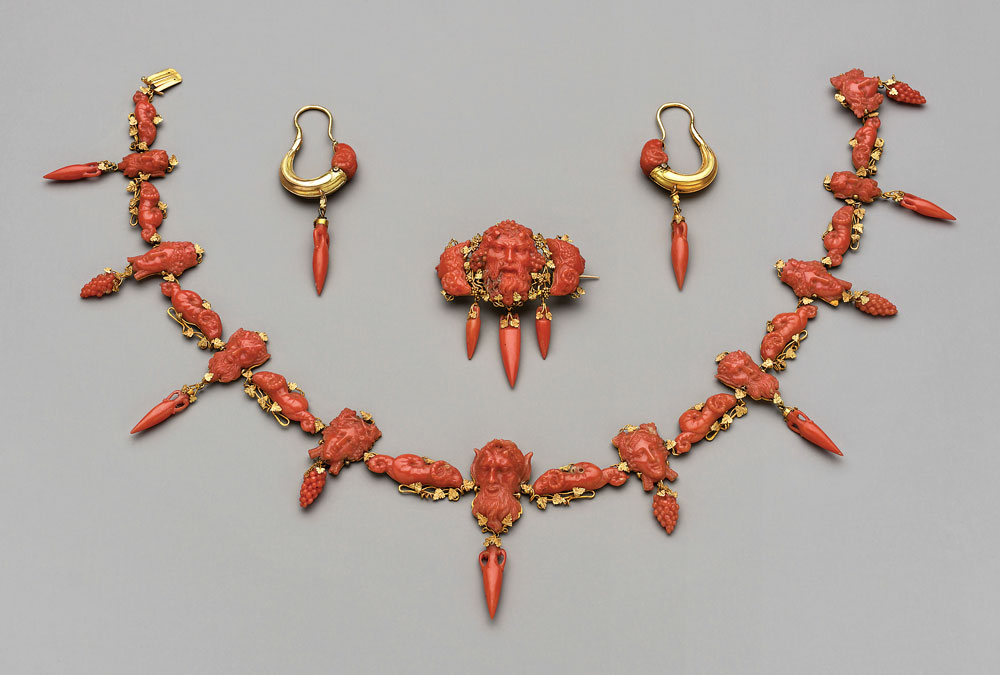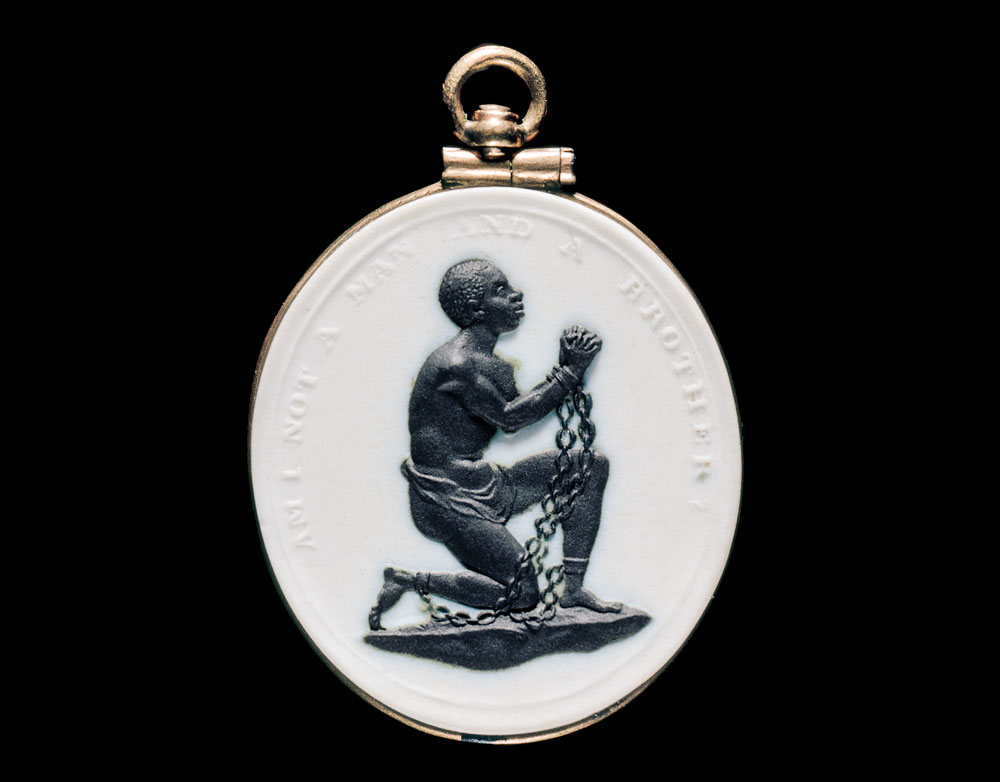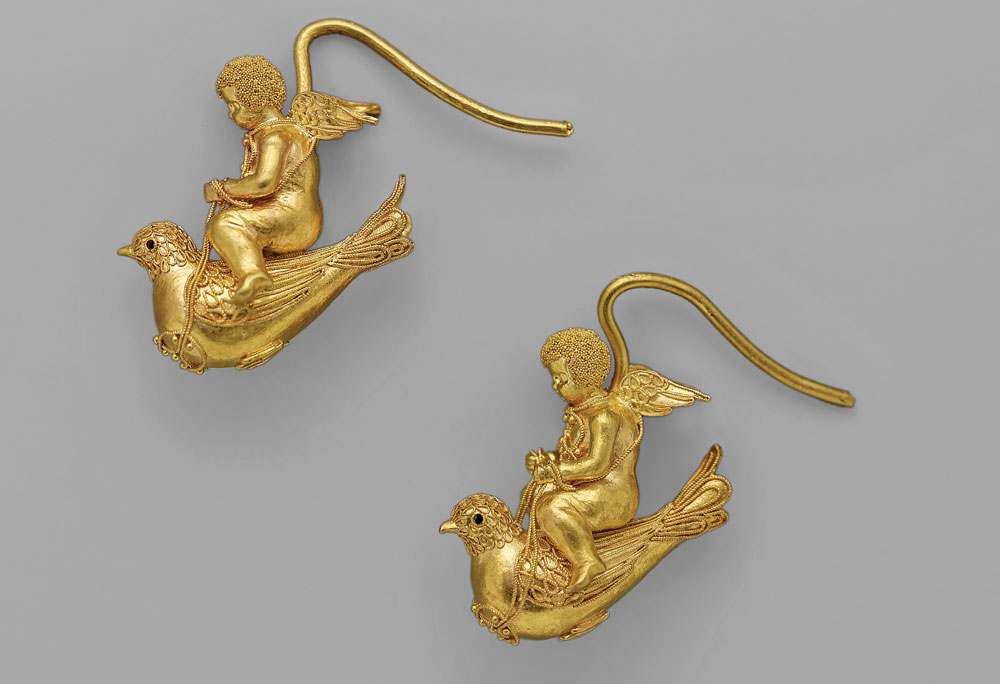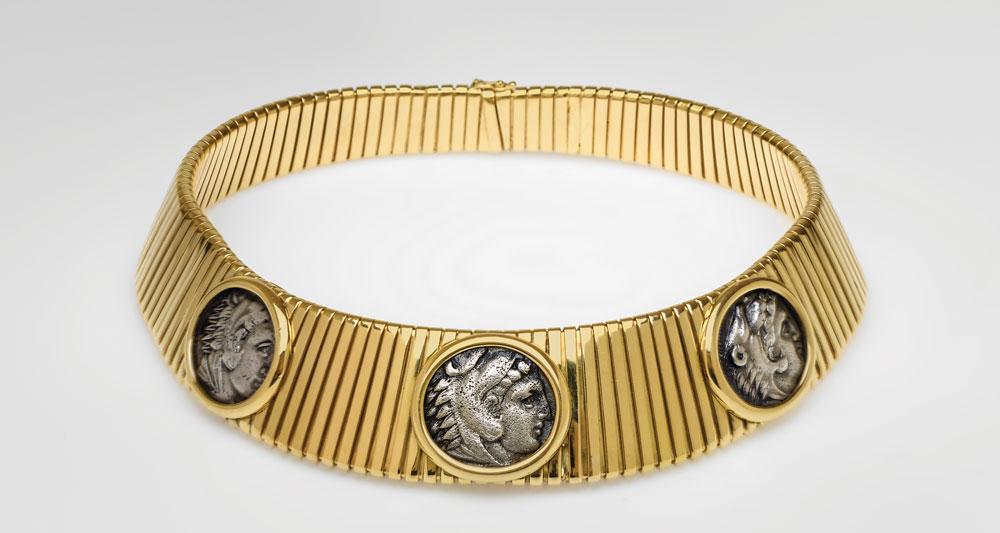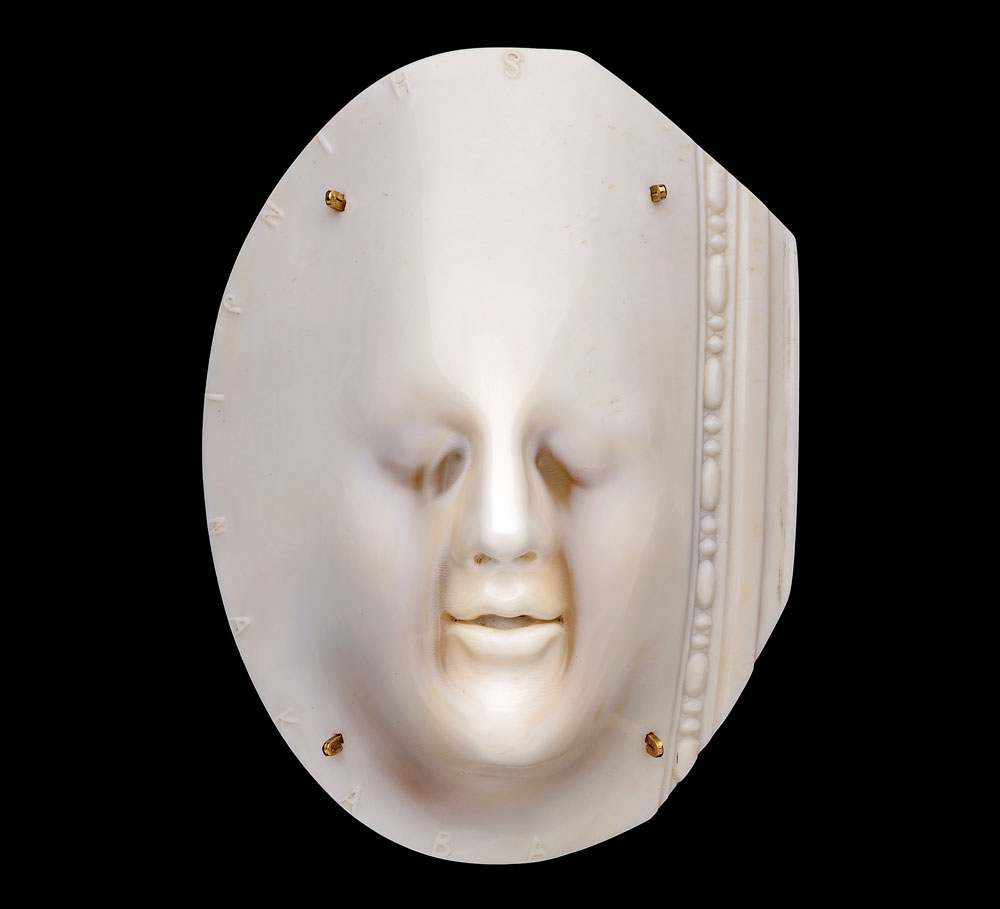Revival Jewelry: Looking to the Past for Inspiration
Past is Present:
Jewelers have a long tradition of looking to the past for inspiration. The Victorian period was particularly strong in revival style jewelry, and the tradition continues today as designers and artists explore the real or imagined past in their work and jewelry houses build archival collections.
Since the Industrial Revolution, forward thrusts in technology have been met with a simultaneous yearning for an often romanticized, simpler past. In the nineteenth century, excavations of ancient sites such as Pompeii resulted in special traveling exhibitions in both the United States and Europe. Publications like Owen Jones’ Grammar of Ornament (1856) illustrated global design elements. The opening of museums such as the Museum of Fine Art, Boston, and The Metropolitan Museum of Art in Manhattan, both founded in the 1870s, allowed new audiences the opportunity to study ancient and historical works of art. Such exposure provided inspiration and visual resources for artists and craftsmen.
Underscoring the tension between progress and tradition, revival style jewelry from the nineteenth to the twenty-first century emphasizes the contrast between antiquity and modernity. While some jewelers directly copied earlier motifs or looked to ancient goldsmithing techniques, others have incorporated ancient artifacts into their modern designs, and many have taken a nuanced approach of combining more than one reference in a single ornament.
In the digital age, as technology continues to accelerate the pace of life, some artists are again drawn to tradition and handcraftsmanship and to the exploration of themes that first presented themselves hundreds, or even thousands, of years ago. Past is Present: Revival Jewelry, at the Museum of Fine Arts, Boston, from February 14, 2017, to August 19, 2018, examines more than 4,000 years of jewelry history through about 80 objects, with a focus on four types of revival style jewelry—archaeological, Classical, Egyptian, and Renaissance.
The jewelry worn by Delia is hardly a focal point in this painting, but her amphora-shaped earrings and what is likely a snake bracelet on her right wrist are reflective of fashions in both ancient and nineteenth-century jewlery. During the 1860s, Alma-Tadema became interested in material life and painstakingly replicated ancient artifacts, like the furnishings copied from objects the artist saw during a visit to Pompeii in 1863.
The inspiration for this necklace was described by the collector William Arnold Buffum in his book The Tears of the Heliandes, Amber as a Gem (1900). He explained how he was mesmerized by the sight of an amber necklace on a Sicilian woman. When the sunlight hit the “gems,” they flashed in colors “ranging from faint blue to deepest azure, and from pale rose to the intense red of the pigeon-blood ruby.” He began collecting the mythic gem and likely had this suite made by the famous Castellani family in Rome. Archeological revival style jewelry was inspired by the art and artifacts being excavated from the ancient world. The earrings and necklace elements are shaped like amphora—a vessel used to transport wine and other liquids. When this jewelry was commissioned, amphora and similarly shaped gold jewelry was being excavated in ancient sites in Italy and Greece.
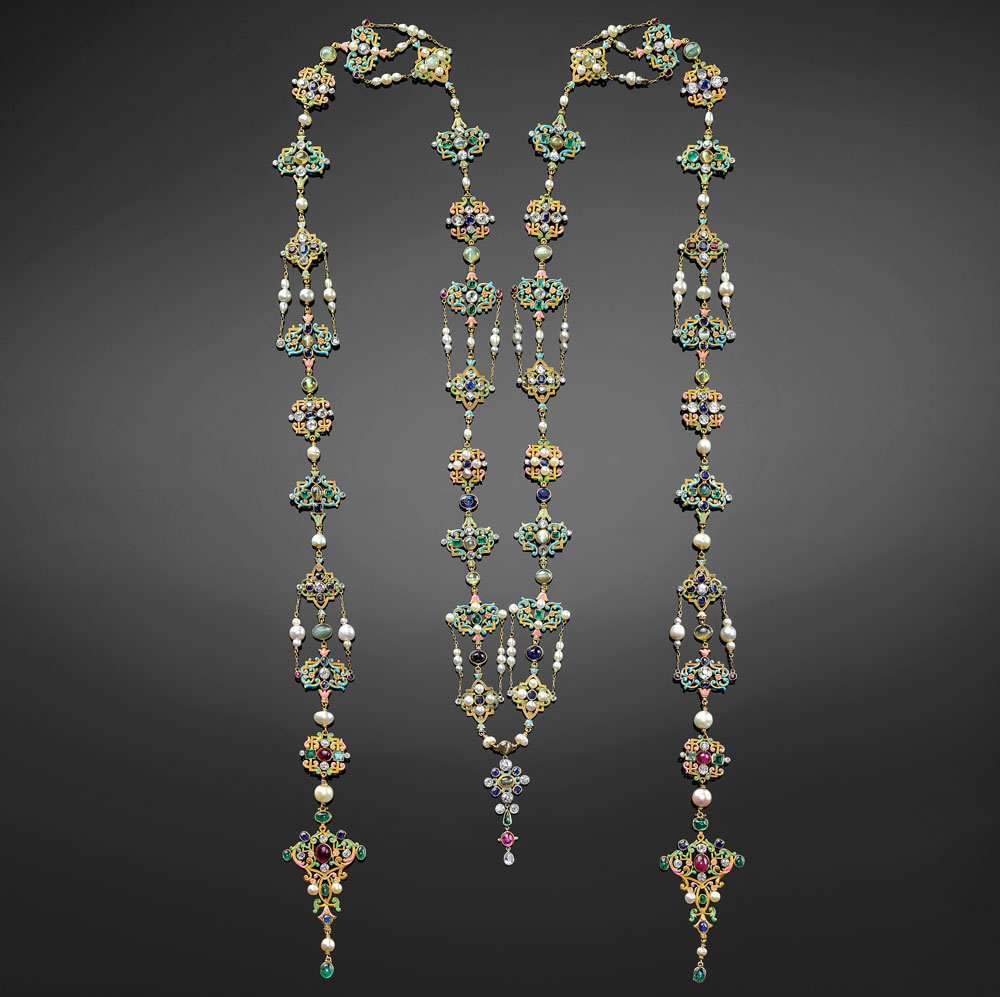
- Renaissance revival neck ornament designed by G. Paulding Farnham (American, 1859–1927) for Tiffany & Co., active 1837–present, United States, 1900–1904. Platinum, gold, enamel, diamond, ruby, emerald, cat’s eye chrysoberyl, sapphire, pearl, 1/4 x 58 inches. Gift of Susan B. Kaplan, 2015 (2015.3184).
In the eighteenth and nineteenth centuries, visitors to places like the Grünes Gewölbe (Green Vault) in Dresden, a unique historic museum founded by Augustus the Strong in 1723, could view a rich variety of exhibits, including Renaissance jewelry. These masterpieces of the jeweler’s art inspired revival jewelry that was colorful and sometimes included allegorical motifs. This long chain, with its wonderful pastel pallet of orange, yellow, green, and pink enamel and semi-precious gemstones, and gentle arabesques design, coincided with a trend toward lighter, more feminine jewelry that was a break from Victoriana and its more literal revival styles. This chain was likely inspired by the lavish ornaments depicted in Renaissance portraiture and conceived as an element of fashionable dress. Farnham first showed revival jewelry around 1892 and continued the theme at the Paris Exposition in 1900 and the Pan-American Exposition in Buffalo, New York, in 1901.
Fortunato Pio Castellani opened his shop across from the Trevi fountain in Rome in 1814. Later operated by his two sons, Alessandro and Augusto Castellani, the shop sold imported jewelry until around 1850, when it established itself as the premier retailer of revival jewelry. Castellani played a central role in igniting nineteenth-century taste for micromosaic jewelry, and by 1866 there were more than a dozen mosaic workshops in Rome. In 1851 the mosaicist Luigi Podio joined the Castellani workshop where he likely completed the micromosaic elements of this necklace and brooch. While much of the firm’s work focused on Etruscan styles, this uncharacteristic necklace with fifteen ancient scarabs and a red, green, blue, and yellow color palette favors the Egyptian taste. In Egyptian art, red represented the desert, green evoked the fertile lands of the Nile valley, blue symbolized the sky and water, and yellow signified the sun. After the Castellani family closed their business in 1930, this demi-parure was sold as part of their personal collection.
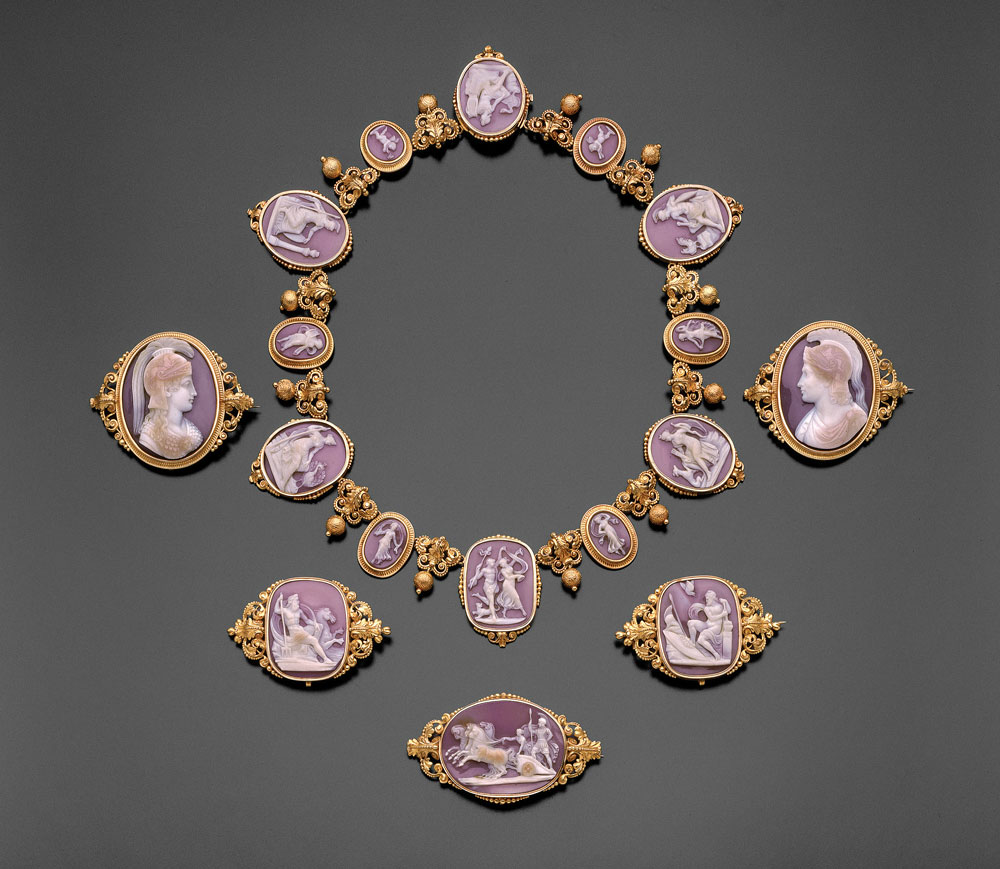
- Classical revival necklace and brooches, France, about 1840. Gold, shell. Necklace: 1-9/16 x 3/16 x 16-15/16 inches. Brooches: 1-3/4 x 2-3/16 x 1-1/16 inches; 1-3/8 x 2-5/16 x 1/4 inches, and 17⁄16 x 2-5/8 x 1/2 inches. Gift of the Misses Cornelia and Susan Dehon in memory of Mrs. Sidney Brooks, 1893 (93.147-152).
Unlike archeological styles, which largely focused on ancient goldsmithing techniques, Classical revival jewelry used cameos and carved gemstones and/or mythological imagery. Cameos have been prized since antiquity and handed down in princely collections. Traditionally carved from shells or hard stones, artists exploited the natural color gradations to create low relief designs. As their popularity grew in the Romantic period, cameos were collected by tourists and jewelers, and later set into jewelry. This necklace and group of brooches include seventeen shell cameos that were probably imported from Italy and set into jewelry in France.
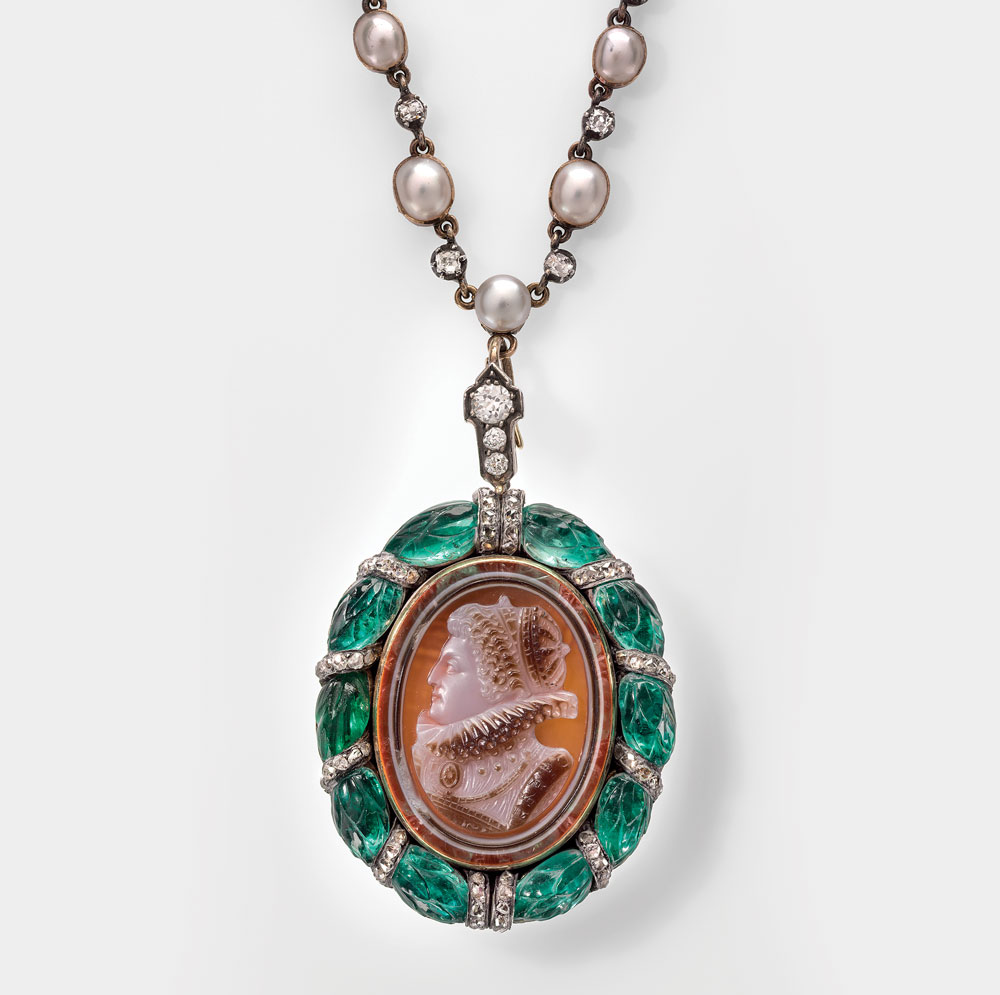
- Cameo necklace of Elizabeth I by Charlotte Newman (known as Mrs. Philip Newman), (English, 1840–1927), and Georges Bissinger (German; working in Paris), England, ca. 1890. Gold, silver, diamond, emerald, pearl, agate, and glass, 1-1/2 x 1-1/4 x 3/8 x 14-3/8 inches. Museum Purchase with funds donated by Susan B. Kaplan, 2011 (2011.7).
In the nineteenth century, while archeologists unearthed ancient treasures from the Mediterranean world, nationalism swept through Europe and jewelry took on artistic and political meanings. Long-established and newly independent countries sought a national vernacular that evoked a glorious past. In England, jewelers like Charlotte Newman explored Renaissance themes in this cameo necklace featuring Queen Elizabeth I (1533–1603). The powerful Tudor monarch’s reign was often compared to that of Queen Victoria, who ruled England from 1837 until her death
in 1901.
Viewed as a rite of passage and an essential part of a classical education for the privileged class, the Grand Tour was a luxury journey that could be drawn out for years. The route from London included the Netherlands and France before an extended stay in the Italian city states. As travelers made their way across Europe they collected souvenirs. In Italy, seen as the birthplace of modern civilization, cities became known for particular types of jewelry—coral from Naples, lavastone and limestone from Pompeii, micromosaic from Rome—these ornaments referencing Classical life with imagery of jovial gods, like Bacchus.
In the eighteenth century, Josiah Wedgwood borrowed from neoclassical iconography when he designed a ceramic “cameo” for the British Society for the Abolition of the Slave Trade. The black and white jasperware medallion shows a manacled slave on bended knee below the words “Am I Not a Man and Brother?” Customized and worn as women’s jewelry and set into men’s watch fobs or snuffboxes, the mass-produced cameo was a highly visible indicator of support for the abolitionist movement. In 1788 Wedgewood sent five hundred cameos, along with a letter, to Benjamin Franklin—then President of the Philadelphia Society for the Abolition of Slavery—with his ardent “hope for the final completion of our wishes” to end the transatlantic slave trade.
First encountering ancient goldwork in 1836, the thirteen-year-old Alessandro Castellani became fascinated by the tiny gold balls, known as granules, that embellish the surface of many Etruscan ornaments. During the second half of the nineteenth century he mastered the granulation technique, and the firm created handcrafted designs with a striking resemblance to jewelry from the ancient world. Displayed at international exhibitions and sold at the family’s shops in Rome, Paris, and Naples, Castellani’s jewelry received resounding praise. After 1870, Alessandro’s star pupil, Giacinto Melillo, who likely made these earrings, managed Castellani’s Naples workshop. Alessandro Castellani recorded few details of his process for this long forgotten craftsmanship, leaving later jewelers to devise their own ways of recreating his technique.
Since antiquity, coins have been fashioned into jewelry. Acting as commemorative or artistic ornaments, they were also emblems of wealth and power. Roman jewelers have a long tradition of designing jewelry that uses coins. This tubogas, or gas pipe, collar, was designed and manufactured by the Italian jewelers Bulgari in the 1980s. It features three coins based on Macedonian ones that were likely made between 350 and 300 BCE. The coins were struck in the name of Alexander the Great, with images of Heracles on the obverse and Zeus enthroned and holding his eagle and scepter on the reverse.
This enigmatic cameo invites the viewer to wonder whether the face is that of a man or a woman? Is he/she sleeping? Crying? Dead? Reminiscent of a Renaissance death mask, Nakaba’s Peace brooch is intentionally ambiguous, and the Japanese artist hopes that the viewer will question the figure’s gender and emotion. Borrowing the ancient cameo carving technique, the brooch is rooted in historical tradition but uniquely modern in its subject and scale.
Past is Present: Revival Jewelry is on view in the Rita J. and Stanley H. Kaplan Family Foundation Gallery, Museum of Fine Arts, Boston, from February 14, 2017–August 19, 2018. For information visit www.mfa.org or call 617.267.9300.
-----
Dr. Emily Stoehrer is the Rita J. Kaplan and Susan B. Kaplan Curator of Jewelry at the Museum of Fine Arts, Boston, and organizer of Past is Present: Revival Jewelry.
This article was originally published in the 17th Anniversary issue of Antiques & Fine Art magazine, a fully digitized version of which if on afamag.com. AFA is affiliated with Incollect.















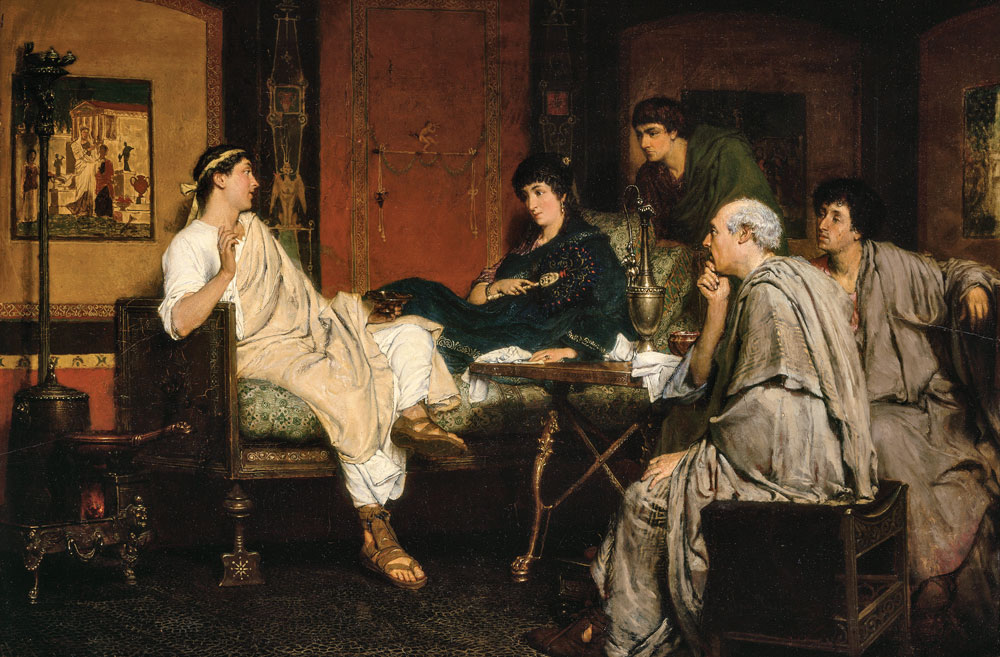
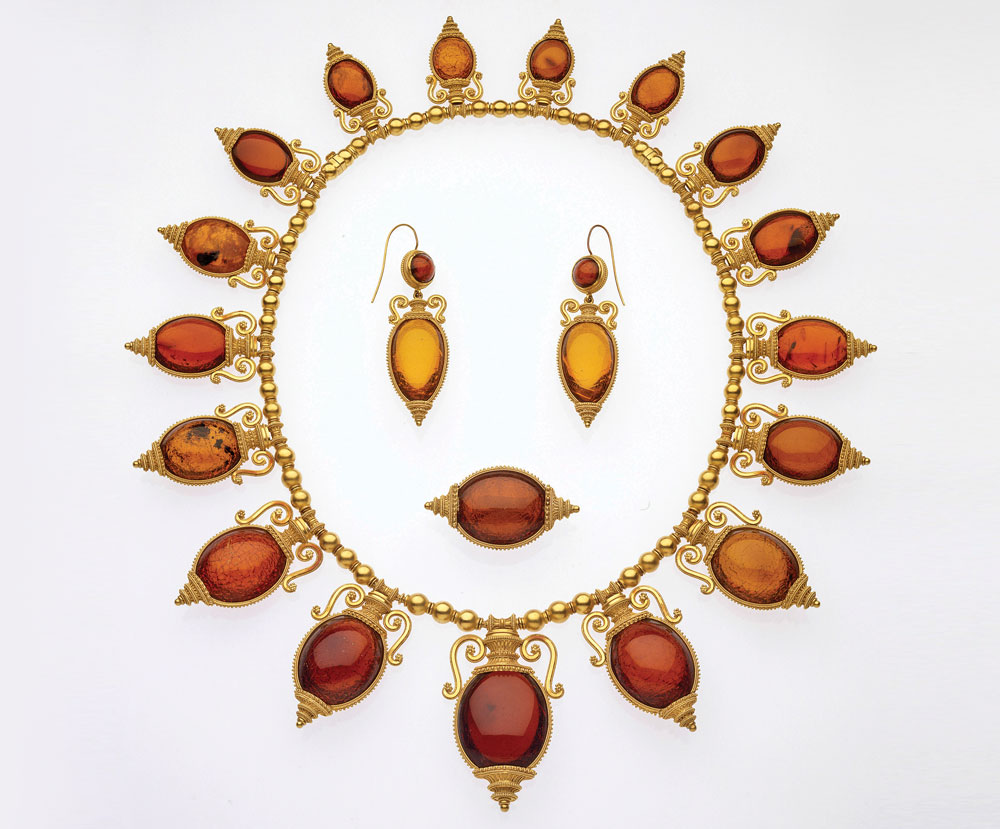
_Castellani_.jpg)
